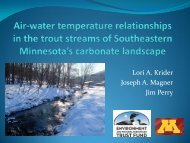Minnesota Water Resources Conference - Water Resources Center ...
Minnesota Water Resources Conference - Water Resources Center ...
Minnesota Water Resources Conference - Water Resources Center ...
Create successful ePaper yourself
Turn your PDF publications into a flip-book with our unique Google optimized e-Paper software.
Poster Session 4:45–5:45<br />
BOOK OF ABSTRACTS<br />
Tuesday, Monday, October 27 23<br />
Reducing Uncertainty and Bounding Variability of Stream Ecosystem Indicators<br />
Christine Dolph, University of <strong>Minnesota</strong>, dolph008@umn.edu; Bruce Vondracek, USGS, <strong>Minnesota</strong> Cooperative Research Unit,<br />
University of <strong>Minnesota</strong><br />
Increasingly, biological indices such as the Index of Biological Integrity (IBI) are used to help make policy and<br />
management decisions regarding impaired waters. <strong>Minnesota</strong> Rules Chapter 7050, for example, requires that<br />
the biological quality of any surface water body be assessed and compared to the biological integrity of reference<br />
conditions. However, the degree and sources of variability associated with IBI values are not well understood.<br />
This uncertainty leads to concerns about the confidence with which such values should be used to list a<br />
water body as impaired. The <strong>Minnesota</strong> Pollution Control Agency (PCA) has assembled a dataset of fish and<br />
macroinvertebrate information for approximately 1500 stream sites across the state, and has developed regional<br />
IBIs for several major river basins. Here use information from the PCA database to examine the variability of<br />
stream ecosystem indicators, and to develop improved methods for assessing and monitoring stream integrity.<br />
The Mound Transit Station Parking Facility – Multifaceted Stormwater Management along Lake<br />
Minnetoka<br />
Troy Erickson, SRF Consulting Group, Inc., terickson@srfconsulting.com; Carlton Moore, City of Mound<br />
As part of the Mound Harbor Renaissance Project, the City of Mound created additional parking with a ramp<br />
to serve park-and-ride customers, office/restaurant space, adjacent redevelopment, a farmer’s market and<br />
the future LRT corridor. Because of the project’s proximity to Lake Minnetonka and watershed regulatory<br />
requirements, SRF developed innovative stormwater treatment methods to reduce the quantity and improve the<br />
quality of runoff from the site. A study of available technology resulted in a site that is environmentally friendly,<br />
economically feasible, and aesthetically pleasing, allowing the City to maximize a Minnehaha Creek <strong>Water</strong>shed<br />
District grant. These methods include permeable pavers, an underground sand filter, and a rain garden as well<br />
as a stormwater pond with a re-circulating pump and boulder stream that enhances the area’s aesthetics while<br />
maintains water, clarity and reduces algae production. The presentation outlines the design and construction of<br />
the treatment train of BMPs and expected system performance.<br />
<strong>Minnesota</strong> Pollution Control Agency’s Environmental Data Access System<br />
Jason Ewert, <strong>Minnesota</strong> Pollution Control Agency, jason.ewert@state.mn.us; David Fawcett, <strong>Minnesota</strong> Pollution Control<br />
Agency<br />
Easily and readily accessible monitoring data helps <strong>Minnesota</strong>ns play an active role in protecting and improving<br />
their environment. Although the MPCA and other organizations collect large quantities of environmental data,<br />
much of it has been difficult to access.<br />
Citizens and environmental professionals now have access to surface water, ground water and air quality<br />
data through the MPCA’s Environmental Data Access system. In addition to data collected by the MPCA, the<br />
system also links to information collected by other organizations such as the <strong>Minnesota</strong> Department of Health,<br />
<strong>Minnesota</strong> Department of Natural <strong>Resources</strong> and the U.S. Geological Survey.<br />
The Web-based EDA system allows users to find environmental data and information using text-based searches<br />
or an interactive, GIS-based mapping tool.<br />
Attendees will learn how to find and download environmental data using the EDA system.<br />
<strong>Minnesota</strong> <strong>Water</strong> <strong>Resources</strong> <strong>Conference</strong>, October 27–28, 20078 38
















